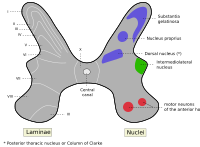
Photo from wikipedia
BACKGROUND Chronic pain is associated with abnormal levels of electrical excitability of the somatosensory cortex neurons. Consequently, recording spontaneous and evoked activities by means of unitary extracellular recordings and local… Click to show full abstract
BACKGROUND Chronic pain is associated with abnormal levels of electrical excitability of the somatosensory cortex neurons. Consequently, recording spontaneous and evoked activities by means of unitary extracellular recordings and local field potential (LFP) are key understanding the mechanisms behind such alterations. There is a growing need to highlight the relationship between spiking activity and LFP. Here, we hypothesized that LFP could be inferred from spikes under evoked conditions. METHOD We detail a process to highlight the C-fiber (pain) evoked activity, by removing the A-fiber evoked activity using a model-based approach. Then, we applied the convolution kernel theory and optimization algorithms to infer the C-fiber LFP from the single cell spikes. Finally, we used a probability density function and an optimization algorithm to infer the spikes distribution from the LFP. RESULTS We successfully extracted C-fiber LFP in all data recordings. We observed that C-fibers spikes preceded the C-fiber LFP and were rather correlated to the LFP derivative. Finally, we inferred LFP from spikes with excellent correlation coefficient (r = 0.9) and reverse generated the spikes distribution from LFP with good correlation coefficients (r = 0.7) on spikes number. CONCLUSION We introduced the kernel convolution theory to successfully infer the LFP from spikes, and we demonstrated that we could reverse generate the PSTH from the LFP.
Journal Title: Brain research bulletin
Year Published: 2021
Link to full text (if available)
Share on Social Media: Sign Up to like & get
recommendations!